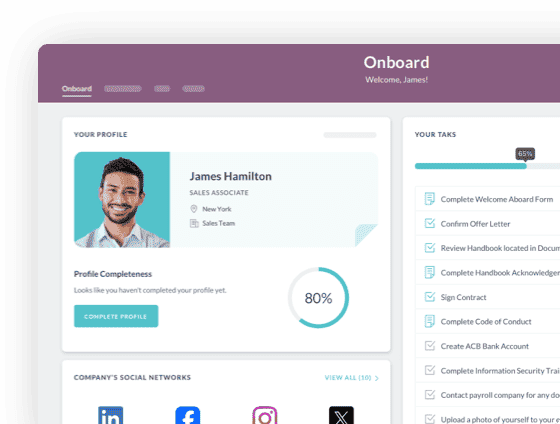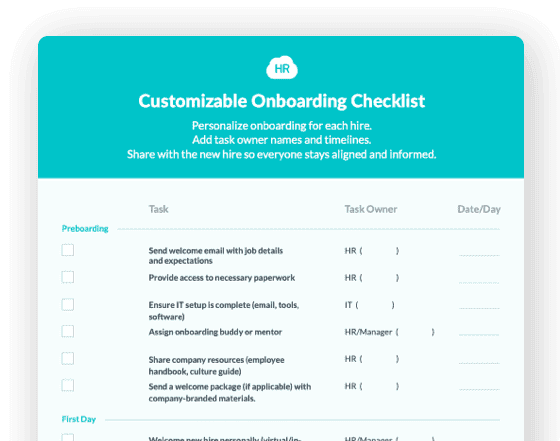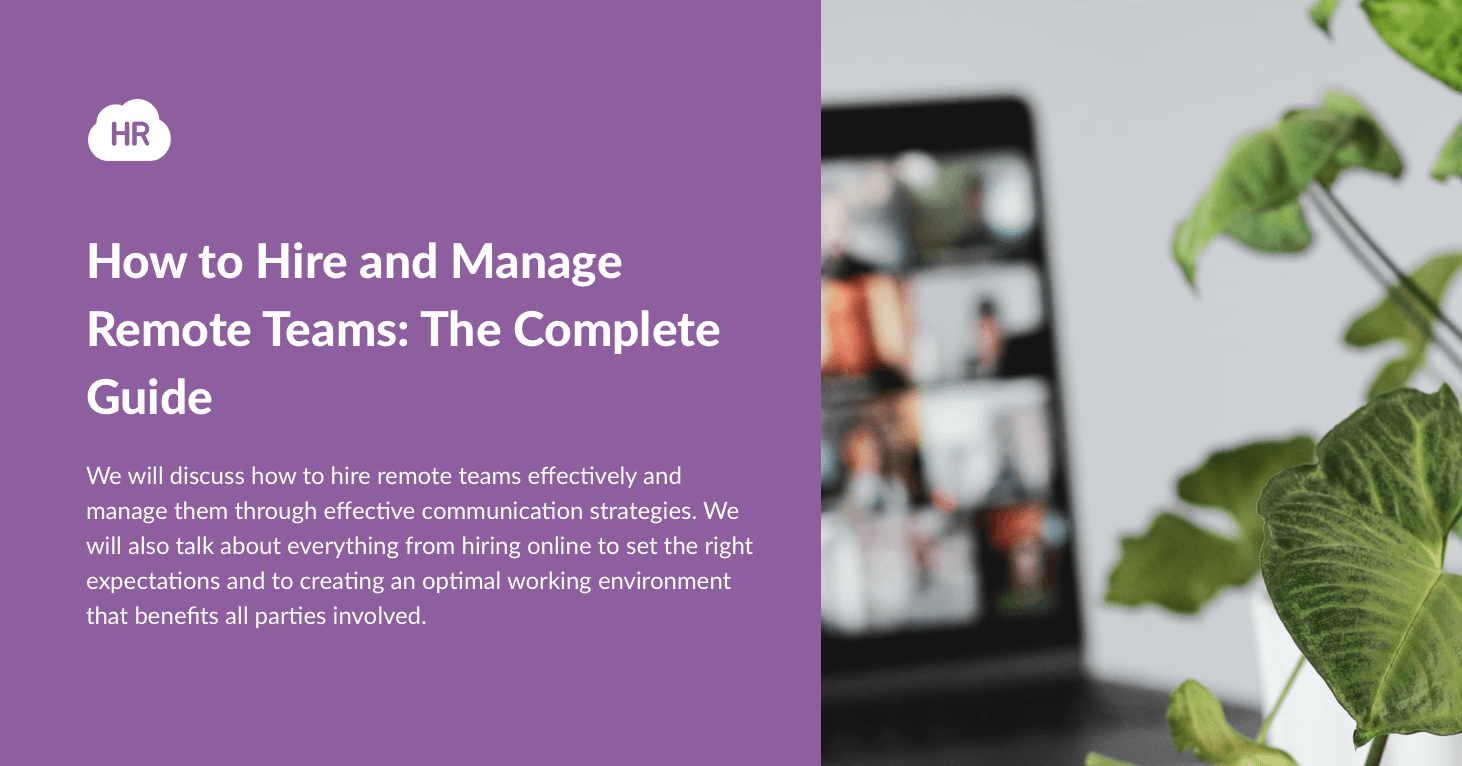

 Cut onboarding time
by 60%—here's the
Ultimate Checklist
that helped do it.
Cut onboarding time
by 60%—here's the
Ultimate Checklist
that helped do it.

One of the most important aspects of managing a business is hiring and maintaining a team. However, this can be challenging when you cannot meet with your remote employees face-to-face each day
Hiring distributed teams can be difficult. You have to find people who will work well together while leaving room for communication and time zone differences. Then, you have to manage them. But how do you keep track of what they're working on? What if there's a problem that needs solving urgently in the middle of the night? When hiring and managing your first remote team, many such questions come up, but this article will help answer most of the common ones and address various remote work challenges.
We will discuss how to hire remote teams effectively and implement a robust remote team management strategy. We will also talk about everything from hiring online to setting the right expectations and creating an optimal working environment that benefits all parties involved.
Remote Team Benefits
In the age of global competition, it's no longer enough to compete on price. Empowering your team with remote working options can give you an edge over other companies that don't offer this benefit and will be left in the dust by their more innovative competitors.
There are many benefits from running distributed teams, but here we'll take a look at just four:
Increased Productivity
The outbreak of the Coronavirus saw a sharp rise in remote working, and despite the release of a COVID-19 vaccine, many people are still working remotely, and it's not just about keeping safe, but also staying productive.
It's no secret that remote employees offer a great way to increase productivity! Being in contact remotely through video conference calls or instant messaging platforms makes it easier for workers at either end to get their jobs done without having any geographical constraints. In some cases, a screen recorder tool is also useful for sharing visual explanations or documenting key discussions for future reference.
This means more accomplished tasks every day - as well as increased remote employee engagement and satisfaction amongst those who participate fully within this type of job policy.
Reduced Turnover Rates
Today, a growing number of companies are using remote work options for effective employee retention. A recent study found that sending your employees home can help them stay in their job longer and be more satisfied in that role.
A nationwide survey found that 73% of employees working from home report higher job satisfaction levels - a number not seen by other types of arrangements within an organization. This highlights the importance of remote employee retention strategies in maintaining a stable workforce.
Allows You to Tap into the Best Talent Worldwide
Hiring remote team members is a great way to find the best talent outside your company's commuting radius. Employer of Record services support this approach by managing compliance, payroll, and benefits for remote workers, allowing companies to hire globally without establishing local entities.
This new trend has made it easier than ever before possible because there is no need to go through hours upon days worth of resumes when you can simply build an online business and chat directly with people who fit what might be needed within any given position.
Reduced Costs
When a company hires remote employees, they can spend less money on office space and other overhead costs. It also helps reduce their tech expenditures because employees use their devices.
Also, employees save in terms of transportation expenses (no need for car or public transport), clothes-related spending, food cost savings, and even child care since many parents find themselves back home with kids during those hours when it used to be so hard finding someone reliable enough who would come to take care of them.
Remote Hiring Downsides
Another problem can arise because when hiring people from non-local markets, they may have reduced trust in the company. While this is not the case for tech behemoths like Google or Amazon, for smaller businesses it may turn into a problem. To solve this, you need to work on your "Employee branding."
This can be achieved through several methods. Registering the company on job posting websites like Glassdoor's Job Search and making sure you have high rankings and positive employee testimonials is one step that your company needs to take.
Another way is to find influencers or people with a large social following on different platforms to promote your company as a good employer. Some of the best influencer search tools can assist you in finding the right people for promoting your company.
The Remote Team Hiring Process
The hiring process is pretty much the same as with traditional teams. The only difference lies in the fact that you'll need to interview and hire people from different locations. This can be an additional challenge for some employers who are not used to it (and may find themselves struggling with time zones or technology during those interviews). But we'll take you through the process. Here are some crucial steps to take when hiring remote employees:
-
Determine Open Remote Vacancies
One of the first steps in hiring remotely for your company is to determine open remote vacancies. This typically entails determining how many new employees you need and can handle, and what type of work needs to be done virtually. If you're looking for remote assistants to help improve customer service for your company, it will be much different than hiring new tech talent (such as developers or engineers). You must understand what positions you need to be filled before diving into hiring remotely. While this may seem like common sense, many companies simply don't realize they need someone else until after they start working and find out they are missing something crucial in their day-to-day work! This can lead to misunderstandings both for the company and employees.
There are three main ways to determine how many remote vacancies you have.
-
Evaluate Your Business Flow
The perfect way to determine how many new employees you need is by observing and evaluating the regular patterns that occur within your company. For instance, one may not be able to pick out any trends or deviations without taking into account other factors such as peak activity times during certain days of the week, resulting in increased staffing needs at those specific periods throughout each workweek. Evaluating this type of data will give insights on what hours/days might benefit from an increased number of workers present, so they don't have too much workload alone while other sections go unattended.
-
How Much is the Budget?
You are looking to hire remote employees, but you're not sure how many new people you can afford? Let your budget decide! While there's no one-size-fits-all approach when it comes to hiring remote workers, your budget should dictate the number of new people that you bring on board, not vice versa. Evaluating your company's expenditure and financial statements estimates how much it would take in both cash and benefits for each position depending on its requirements, and therefore how many employees you can afford. Just make sure this estimate still leaves room in case any positions prove cheaper than expected or more expensive than expected so as not to have too many open slots at once without funding them adequately.
-
How is the Customer Experience?
Customer experience is a key indicator of the number of new employees you will need. If customers are experiencing long lines or have difficulties with their order, this often means that there aren't enough staff members on hand to meet demand and improve customer engagement as quickly as possible. It's therefore important for business owners/managers to make sure they always keep track of how many people are working in certain departments when using feedback from survey responses or observation during peak hours. Such periods can provide valuable insight.
1. Post a Proper Job Announcement
The key to ensuring a successful remote hiring process is having an effective and quality job posting. Whether you are posting an announcement on your website or using LinkedIn ads, you want your potential employees to know exactly what you're looking for and how they fit into the picture so that it's clear from day one of meeting someone new in-person or virtual meeting platforms like Zoom. Some features of a proper job announcement include:
-
The Culture of Your Organization
Your job posting is an opportunity to sell your organization. It's not enough just listing some of the basic requirements like qualifications and benefits. You must paint a picture for potential employees with words that will leave them wanting more. Ensure this section speaks in glowing terms about what it means to be part of your company culture by providing details on how their values are reflected throughout all levels from management. Include why this opportunity is different from others on offer; what makes it worthwhile? Show them how their skills will be put into practice at work to meet organizational goals. Give specific examples of tasks they'll engage with - "you would collaborate..." rather than just saying 'collaborate.' Be creative!
-
Detailed Information about the Position
A good job posting should provide detailed information about the position. This includes identifying what title, department, and classification it is in and hours of work expected from applicants for that specific job listing. It allows potential candidates to know up front whether they'll enjoy working there or not.
-
An Objective - (for the job)
The best way to post your job is with a clear objective. You should write what the candidate will do and why you're looking for someone in that role. You must also define the responsibilities of their roles and identify any key tasks or responsibilities.
-
Qualifications
A well-written job posting should have all the information necessary to get a suitable applicant. This includes qualifications, education levels, and experience needed for success in this role and any other requirements that must be met before consideration can occur during an interview process.
-
Salary and Benefits
A good job posting is upfront about pay and benefits; it doesn't skimp on the truth. Your posting should straightforwardly communicate this information so people can make an informed decision sooner rather than later - which means you need to be as honest with them as possible.
2. Time for Online Headhunt
Now that you already know how to create a good job posting, how about sharing it to reach potential? A popular way of hiring remote teams these days is online headhunting - simply online advertising the position. This involves posting ads on websites such as LinkedIn and re-posting them across social media platforms like Facebook and Twitter. When it comes to LinkedIn, you can also custom search for people who match your needs and contact them directly or collect email addresses and reach out to them via email.
You can use a social media scheduling tool to share the advert regularly and increase the chances of reaching as many people as possible across various social media platforms. Social media communities, like Facebook groups dedicated to specific professions, are also a good place for finding talent. Creating and sharing job postings online will help you reach your desired population of candidates for them to apply for the position available at your company or organization. Online postings also create an accessible networked platform. When it comes time to look at resumes, all applicants can be seen side-by-side, saving companies valuable time between fillings. This process also involves shortlisting, interviewing, job simulation, and hiring the most suitable for the position. Doing this online saves time and resources that would have otherwise been used in the recruitment. And talk about convenience! You can conduct interviews at any time.
Do the Paperwork
Once you choose a candidate to join your team, it's time to think about finalizing the hiring process and making it official. Whether it's full-time employment or a trial period, make sure to have it all on paper. Prepare the contract and other documents the candidate should sign, and send it over to them to sign. This can be done with a document signing software, or they can sign it by hand and send back the scan. No matter the logistics, it's important that both you and your candidate are on the same page with the position.
3. Conduct a Successful Onboarding Process
The last step to a successful hiring process is developing an effective and efficient onboarding system.
Employee onboarding is the process of getting new employees fully up to speed with what they need to do, where things are located, and how it all comes together. It can be very intimidating for someone who has just started their first day on-site. So here are some tips:
-
Make Your Objectives Clear
Help your team members feel at ease by delivering clear expectations from day one. Nothing makes anyone more frustrated than being given unclear instructions or having an unfamiliar environment imposed upon them without warning. Whether you’re working on improving lead lifecycle, boosting sales, or creating a new marketing campaign, it’s important to keep everyone on the same track.
Be creative in engaging staff through personalized training sessions tailored around individual needs. Make sure everyone involved attends these training sessions, including managers, so discrepancies don't arise later down.
-
Share Your Mission, Vision, Values, and Operation
To ensure a successful onboarding process, managers must communicate their company’s culture and values from the beginning. This can be done by using different project management tools, integrating software, and keeping in constant touch with their teams.
This creates an environment where new employees can connect with its vision, which in turn develops into pride for working at your organization as opposed to feeling like they need more information or guidance when joining the staff.
You can create videos alongside customized eLearning templates. One of the most common video presentation ideas is online podcasts sharing key moments & achievements while also providing info about policies, structures, and protocol.
-
Create a Personal Onboarding Experience
A personal, interactive onboarding experience can be an excellent way to welcome your recruits and introduce them not only to existing staff members but also key executives.
Consider developing friendly eLearning videos for this purpose- it'll make you look good in front of the team.
-
Evaluate Your Program
It's important to assess whether the onboarding process has been successful by measuring how well your online training program prepared them before giving challenges that will likely be faced in future jobs, as well as identifying any areas where improvement could use some help.
How to Manage Your Remote Team Effectively?
The ongoing COVID-19 pandemic has caused many companies to reassess how they work. One of the most common changes is for employees to telecommute, though some remain skeptical and question whether such an arrangement would be productive enough given potential failures.
To increase collaboration between all members involved both physically present as well distributed across time zones, we highlight six tips to maximize workplace productivity.
1. Set Expectations and Performance Metrics
When hiring someone remotely, one of the first things you should do is set expectations for them regarding performance metrics and how their job will be different from those working face-to-face at your location. Otherwise, they may give up before even starting because it was so difficult.
So how do you set expectations and performance metrics?
-
Define Objectives
Setting expectations and performance metrics is vital for the success of any organization. By establishing quarterly objectives or goals with your employees, you can ensure that they know what needs to be done to accomplish them by defining clear key results that will allow autonomy over their responsibilities.
Setting measurable targets ensures there's always something at stake if an employee doesn't meet standards on his/her part because he knows how much trouble it might cause company-wide rather than just being told: "you didn’t do well."
-
Set Expectations Early
Setting the stage for success early is essential to avoid any surprises or problems later on. This can be done by setting clear expectations with new employees from day one and then following up periodically during employment as needed.
-
Enhance Accountability
Setting expectations is a critical part of any company's culture. You want your employees to feel accountable, but you also need to be realistic about what they can accomplish given how much work there has already been done and their skillset (or lack thereof).
One way you can do this while still setting realistic goals and allowing room for growth on the job would be by making sure that your staff recognizes just how much responsibility they have in reaching those targets.
Clear direction from management about what needs doing right away or down the road (and when), makes success more likely because workers know precisely where Improvement lies - with them.
-
Always Give Feedback- Positively and Creatively
Giving meaningful feedback is a tricky business. If you give vague or negative messages, the employee will eventually tune them out and stop listening to what's being said about their performance- just like they do with anything else that doesn't resonate with who they are as an individual in this world.
For management comments on one’s work to truly inspire change within an organization and lead towards improved results, leaders need not rely solely on critique. Rather, there must exist some kind of reasoning behind why any given situation happened how it did; whether by telling tales from personal experience or utilizing anecdotal evidence collected through observation over time.
-
Set Deadlines
To be successful, the goals you set must have some sort of timeline, and if they aren't met, there should still be consequences.
A common way to do this is by providing deadlines for when targets need to be met, so your employees have motivation, knowing what will happen in case milestones are not reached on time.
2. Consider Remote Team Management Platforms
Consider using remote team management platforms to help manage your work from home or telecommuting. Remote teams can be a challenge to manage, and although agile organization and other methodologies simplify it, it's still not just a matter of finding an internet connection that has good connectivity; you also need the right leadership and effective communication between them all if things run smoothly.
Management platforms help remote teams be more effective and efficient. They can also significantly encourage remote workers, who may otherwise feel isolated from their team or organization due to physical distance between them.
So, how do you choose the best remote team and task management software?
With remote work platforms, you'll want to make sure that the software has all of your needs covered. A good remote work management platform will feature:
-
A task manager for planning out projects and tracking deadlines
-
Time management tools or calendars that allow employees more control over how they spend their day in an efficient manner
-
File sharing capabilities that give workers access to files shared by teammates.
-
Collaboration features that allow them visibility into one another's progress
Some of the most popular remote team management platforms include;
- ClickUp
ClickUp is an incredible enterprise project management software that is suitable for any business type and size. This platform offers communication, task assignments with statuses (complete, incomplete, etc.), alerts (so you'll never miss an update), as well as the ability to assign comments or tasks directly from your browser toolbar, just to mention a few.
You can also mark them resolved if they're still open on another device, no need to send emails back-and-forth between team members during these types of conversations. Just have everyone glance in real-time via the ClickUp’s activity stream while collaborating remotely.
- Asana
Asana , compared to ClickUp, helps streamline communication across remote teams. As a business owner, you know how important it can be to stay on top of your deadlines - which means making sure all projects involved have clear goals for their completion.
With this tool in place, there's no need to worry about keeping track or managing tasks. Instead, they'll come naturally (and easily) because everything has its location within the program. You won't even miss out on valuable insight from other apps like Google Drive or outlook since there are integration capabilities with hundreds of more applications. Every part will sync together beautifully between collaborators' devices.
- Trello
Whatever your job may be, Trello is an excellent tool for collaboration and organization. Organizing projects into boards gives you insights about what's being worked on at any given time while also allowing each list of tasks to have its level of prioritization or completion status.
This ensures that everyone stays up-to-date with where things stand with one another without having entire discussions over emailing individual coworker backstories every couple of minutes asking 'if anyone knows anything new that happened since we last spoke.'
Trello isn't just great if multiple people are working together—you can also use it solo! You'll quickly find yourself jumping from task list item A onto B because each slide automatically highlights changes made since last week when stacked.
- Slack
With its virtual office-like features, Slack is a great way for teams of all sizes to bring together their work communication in one place with its virtual office-like features. It provides real-time messaging and search abilities that make it easy to find what you need when communicating with others on these platforms.
You can sync other tools with Slack, so you get notifications from them as well. This way there are no more missed deadlines or important messages flying by without being noticed.
In the bigger picture, you will also need to secure the usage of these types of platforms for employees. If, for example, they need an email to sign up, consider an SPF record checker to track the security of both senders and receivers. Especially with remote work, you have to make sure everyone is safe online and there are no data leaks.
- HR Cloud
Unlike the other management tools, HR Cloud offers a one spot for enterprise-level human resources solutions. No matter the size of your company or the number of employees/teams, the platform provides employee engagement, onboarding, communication, and reward solutions for businesses in all industries. Scale your brand, engage more employees, and ensure overall productivity growth with HR Cloud. Moreover, it also gives companies the security measures they need, including confidential data and compliance.
HR Cloud will take each employee by the hand and walk through the process without you having to worry about missing anything out. You can also integrate third-party tools such as background checks, payroll, etc.
3. Automate Tasks
Telecommuting is a popular option for the modern workforce, but staying on top of everything can be challenging when you're not at your desk. That's where automation comes in!
It may seem like an intimidating process, but there are tools available that make this easier than ever before.
So, what exactly is task automation?
What does it mean to have a witless work environment in which repetitive, manual tasks go undisputed? For some people, this means they are doing all the heavy lifting themselves. For others, these movements and more important decisions can be made by an algorithm or computer program without any input from them at all.
Task automation, therefore, is the use of a computer program to do repetitive tasks that would otherwise be manual automatically. For example, with email automation, you could have a program that automatically sends emails on your behalf when certain events happen to an account, such as bill payment, creating an invoice online, or sending reminders about outstanding invoices. Email marketing for restaurants can greatly benefit from task automation as well, streamlining reservation confirmations, special offer notifications, and customer feedback requests seamlessly into their communication strategy. Automation will easily become a part of your outbound email marketing strategy since it allows you to complete all tasks in a simplified way.
When using such tools, however, make sure to still keep an eye out for the campaign results, to ensure high email deliverability and avoid any potential issues.
Benefits of Task Automation
Tasks are a necessary evil in any workplace. No one wants to do them, but they have to be completed on time and with minimal input from you - the person who loves their job! But how does task automation help?
Well, for starters, it can make our work easier by taking away some responsibility, so we don't feel like all eyes are constantly upon us at once.
Some more benefits of using automation include;
Reduced Operational Costs
Task automation is the way of tomorrow! Say hello to a more streamlined operation with reduced costs and tons of time. You can cut down on your hiring needs by automating tasks like data entry while saving money in the process. Automation also helps identify redundant processes within an organization that may need removal completely from day-to-day operations.
Enhances Efficiency
Task automation is a great way to increase reliability, reduce human error, and make sure that tasks are completed without flaw, ensuring product excellence.
In the world of work, it can be used for any task which requires repetition or consistency over time, like data entry, while at home, you may find yourself automating everyday tasks such as grocery shopping online using an app, so all your needs are taken care of before they become overwhelming.
Ensures Productivity
Productivity is about more than just getting your work done. It’s also about unlocking the full potential of every team member, which includes giving each member time to take on higher-level tasks with increasing frequency so they can grow within their roles at a company.
This type of workplace automation takes the simple tedious jobs off employees' hands for them to focus solely on challenging projects which may require specialized skills or knowledge.
A good task management software has the following features:
-
It should be easy to use. A program that is difficult or takes too much time on your computer screen, which doesn't justify the need for one.
-
Good automation software also needs to perform more than one automated function. You shouldn't buy different software for every task.
-
And finally, the cost must justify benefits meaning it doesn't matter the price or using these programs as long they offer value by giving faster results and at a much lower cost.
4. Train Your Team
One of the most important things for a successful remote work-life balance is training your team. Regularly scheduled training will ensure that everyone on board has an optimized perspective towards how they should be working from home or remotely, which means happier employees and increased productivity in general.
Here are some tips on how to train your employees to work remotely.
Develop an Easy to Access Guide
The first step to training your employees for remote work is by developing a guide that they can access when needed. This should provide them with the necessary information and knowledge required, as well as what type of tools and materials are required to maintain productivity while there.
It might be as simple as creating an easy-to-read PDF document or an AI tutorial maker to generate step-by-step guides or putting together short videos into one video course with commentary from experts at home office locations; whatever works best suits what they need. For example, if you plan on expanding your marketing department, make sure they are aware of influencer platforms such as Upfluence and have basic knowledge of other digital marketing tools used in your company.
Come Up with an Effective Training Method
To make remote work easier, employees should be trained on how to do their jobs effectively.
Several methods of training can help with this goal:
-
Synchronous learning - refers to online real-time classes
-
Asynchronous webinars where trainees access pre-recorded content at a time they choose for themselves
-
Blended learning combines both types by allowing people to attend online sessions in addition to accessing pre-recorded video content when it is more convenient for them.
Find a Good Training Platform
You're looking for a new way to get your employees on board with remote working. You've considered all the benefits, like lower costs and more flexibility, but there's one thing that remains an obstacle: how can you make sure they'll use these tech products in their everyday lives?
A good place to start would be by identifying suitable learning programs or tools available now from different providers to train them on how to work remotely or use these programs. But how can you conduct remote training sessions? Training platforms, of course!
Depending on your preferred training methods, find the right training program by evaluating one of many collaboration tools available such as Learning Management Systems (LMS), Learning Experience Platforms, or Remote Video Training Tools such as Zoom for business or Google Meet - make sure it fits with what you need. This is an important step not only for professional development but also for team-building. Your employees should learn business growth basics such as what sales leads are, how the marketing funnel is built, etc.
Ensure Multi-Device Accessibility
Remote work is a great way for employees to be able to learn anytime, anywhere. But it can also cut down their engagement and performance if they don’t have the right tools with them at all times.
Build a website or app that works well across different devices such as tablets and smartphones so workers never miss out when learning something new about their job responsibilities. Ensure your software makes training on the go easy...
The advantage of mobile apps is that they provide a fast communication method. As we carry our phones everywhere, employees will be able to receive instant notifications
The advantage of mobile apps is that they provide a fast method for communication. As we carry our phones everywhere, employees will be able to receive instant notifications/
Allow Socialization
Unlike traditional in-office training sessions where employees enjoy snacks while learning something new, online training sessions can sometimes be boring.
You must find ways for remote teams to connect over larger training initiatives for everyone on the team to understand what they are working towards. It can be a great way for them to learn new skills and share ideas.
Start with creating regular chats or Q&As through communication software such as Slack where people could ask questions about different programs and share progress updates.
Check-in With Your Team Members
Remote team managers must encourage communication and coordination among their staff. This means that it's important for a check-in session with each member every day, week, or two weeks depending on the size of the company, to make sure everyone is feeling fulfilled and committed to achieving goals as an organization, whether it’s improved user acquisition or better engagement.
Establish a Healthy and Engaging Company Culture
Healthy and engaging company culture is an essential component to managing remote teams effectively. Company culture is a huge part of how you manage your remote team. If your company has an unhealthy or disengaging environment, it's going to affect everyone on the payroll.
A healthy work-life balance should always be a top priority for any business. Establishing this type of environment for your business can be difficult at first, but there are ways to make sure it's successful from day one.
One of the best ways to do so is to encourage collaboration between employees by fostering camaraderie across departments, so they know how much their hard work impacts not only themselves but also others around them.
This will ensure higher productivity rates because it makes them feel connected with one another and eager about coming to work every day. After all, they know what awaits them when they arrive. Neither fatigue or boredom has time to set in before the following day.
Organizing The Budget And The Payment Process
Another critical aspect that you should consider when managing a remote team is payments. While the advancements of technology and the rise of a plethora of digital payment options have seemingly made it easy to send money internationally, it also opened doors for many challenges, and nuances that you need to consider before you start paying to your employees. Below are several things you need to consider that will greatly simplify the process of handling the process of paying your remote workforce.
-
Negotiating the salary - This one may be a no-brainer, but you need to know the exact amount you’ll need to pay. You will need to negotiate the salary during the interview. However, if you are working with people across the world, this process can be a bit harder, depending on the tax regulations per country. Therefore, to avoid any unpleasant situations, make sure that both you and your employee know the exact number they will receive.
-
Deciding on the payment schedule - This is also a key aspect to discuss with your team members in case of remote work. What payment options can you offer? If your business is ready to offer weekly payment options, some employees may be happy to hear about that. Additionally, creating a pay stub for each payment period can help maintain transparency and ensure employees understand their earnings and processes. Another important aspect is that the international money transfers may take days and if the employee was expecting the payment on a specific day, and there is a delay, they might find themselves in an unpleasant situation. Considering these nuances is key to making sure that everyone is happy.
-
Diversify your payment options - This is especially crucial if you have an international team. Depending on where you and your employees are located, some of the available payment processors may not work for both of you. For example, if you prefer to make international transfers through PayPal verified account, and your employee is in a country where PayPal doesn’t operate, you might have a problem. Make sure to research several payment options, and try to incorporate as many as possible into your payment options.
-
Consider using cryptocurrencies - The rise of technology and the digital world has transformed the world of finances as we know them. Cryptocurrencies have been the most recent addition, and have seen steady growth during the last several years. Currently, more and more brands and companies start to accept cryptocurrency payments, as well as pay their employees in crypto. Two of the key reasons for this are data protection and instant transfers. While digital payment options availability has made it easier to make transactions, it also created more opportunities to avoid data breaches and fraud. Cryptocurrencies are one of the safest ways to solve this, and they also eliminate the issue of delayed money transfers. Ethereum cryptocurrency is one of the best options for this case. Other popular options include Bitcoin and Litecoin.
Additionally, you can consider using a crypto portfolio tracker to always be on the know about your crypto assets, and how much you should send away.
Setting up global payment does come with its challenges, but thorough research done once will greatly simplify the task later.
Challenges of Managing a Remote Team
The world is changing, and so are teams. With the rise in remote work, it has become much more common than ever before for companies to be composed of employees who do not always have to go into an office.
This can make managing people difficult at times because you might find yourself trying new things out without knowing if they will pan out like planned. So, whether you’re a huge branding company or an online electric skateboards store, obstacles and failures are inevitable.
The most common challenges associated with managing a remote team include:
-
Communication
The most prevalent challenge faced by managers of remote teams is communication.
It can be difficult for people worldwide to communicate effectively while working in different time zones and combating factors such as poor connectivity.
This is why it is essential to use a project management tool like Asana to ensure everyone works on a single dashboard and stays up to date in spite of these challenges. Additionally, to counter the negative effects of slow internet connections, you can use co-browsing tools like Surfly, instead of screen sharing tools like Zoom, since co-browsing technology requires a much lower bandwidth to operate.
-
Difficulty Tracking Productivity
Tracking work and worker’s productivity has been one of the greatest challenges for managers. Without knowing how much someone accomplishes in days, weeks, or even months it becomes difficult to tell if they're being underutilized or overworked when working remotely.
-
Scheduling Difficulties
The biggest challenge for remote teams is scheduling a video meeting or a phone call if you have a business phone system setup since it can be difficult to find the perfect time zone that everyone will be able to jump on. Use a calendar tool like Google Calendar to counter this problem.
-
Finding Self-Driven Individuals
Finding self-driven individuals is always difficult, but it becomes exponentially more challenging when you have to manage them from afar. When they are unmotivated or lack self-drive, then it becomes difficult for managers to motivate them and get work done.
-
Building Trust
Building trust is difficult for remote managers and team members in different locations. In the hiring and onboarding stages, a non-disclosure agreement is approved as the first step to building trust. Managers worry that workers aren’t completing work while the latter have concerns like payment being made promptly- or at all.
Conclusion
There are many benefits to hiring and managing remote teams, including lower overhead costs and higher productivity rates. However, it is important to make sure your team members have the tools to succeed.
To do this successfully, you'll want a few basics like chat software and video conferencing capabilities. But there's also some strategy involved too.
Self-starting, self-directed employees are crucial to a successful remote team. Remote teams need to be managed closely, and managers should provide clear expectations upfront for what they want from their hires. Without these guidelines, it can lead to issues with communication or even productivity.
Moreover, clear feedback mechanisms also help make sure that all members of your remote team have an equal understanding of what is being asked of them. This will ensure that no one feels left out in terms of responsibilities or feels like they're working harder than others on the same project.
Keep Reading
BambooHR vs HR Cloud: Which HRIS Actually Scales for Growing Companies?
TL;DR: BambooHR's apparent simplicity becomes a major limitation as companies scale past
The Hidden Metrics of Frontline Success: Beyond Engagement Scores
"What gets measured gets managed, but what gets measured well gets transformed." — Peter
Embracing Diversity: Recognizing Different Cultures in the Workplace
Workplaces today reflect the incredible diversity of the world around us. People bring
Like What You Hear?
We'd love to chat with you more about how HR Cloud® can support your business's HR needs. Book Your Free Demo

Build a Culture of Recognition. Boost Engagement. Guaranteed.
Workmates empowers employees to stay informed, connected, and appreciated—whether they’re on the front line, in the office, or remote. Recognition drives 12x higher engagement.Trusted by industry leaders in every sector




Cut Onboarding Costs by 60%.
Take the confusion and follow-ups out of onboarding with automated workflows, digital forms, and structured portals—so new hires ramp faster 3X quicker.Trusted by industry leaders in every sector





